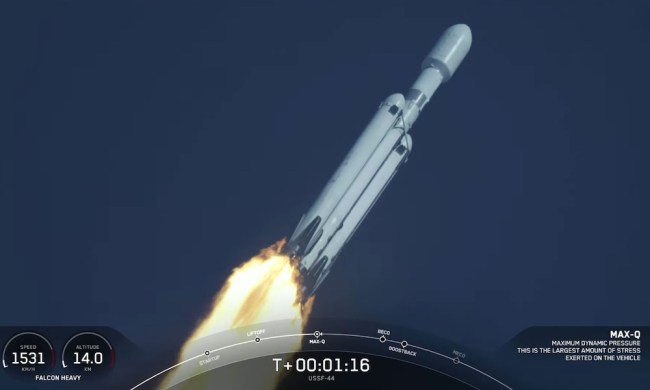- Home
- Space
Space
About
Make no mistake: we are currently living in the Golden Age of space exploration. Right now, as you read these words, we have robots on the Moon, autonomous rovers on Mars, and roughly a half dozen asteroid mining companies prospecting for precious metals in space. What will happen tomorrow? Tune in to DT’s space coverage to get all the latest news and commentary on everything from SpaceX to space junk, and keep pace with all the most important things happening in the final frontier.

Watch NASA’s cinematic trailer for its upcoming streaming service
NASA has released a trailer for its upcoming NASA+ streaming service, a free offering that's part of a major effort to revamp its online presence.







Astronomers spot first evidence of two planets sharing the same orbit
Two planets in one orbit? It could be possible, according to new research looking at planetary system PDS 70.

Car-sized object washed up on beach could be space junk
A large chunk of metal that suddenly appeared on an Australian beach is believed to have fallen from an Indian rocket.

Could the key to living in space be … a good lighting system?
Lighting is typically more of an afterthought when it comes to space habitats, but as it turns out, it may just be the most important part

Trio of Orion spacecraft prepped for NASA moon missions
NASA has shared an image of three spacecraft that will play a central role in its next three Artemis missions to the moon.

This star shredded its companion to create a stunning double-lobed nebula
Nebulae are some of the most beautiful structures to be found in space. A new image from the Gemini South telescope shows an usual double-lobed nebula.

Perseverance rover finds organic molecules in Mars’ Jezero Crater
The molecules are associated with life but can be created by other processes. So they aren't proof there was life there, but they are life's building blocks.

Here’s why scientists think life may have thrived on the ‘hell planet’ Venus
Venus is one of the most brutally inhospitable places in our solar system, but many scientists think life could have thrived there at one point. Here's why.

Inside the crazy plan to scoop up and bring home a bit of the Venus atmosphere
Most missions collect samples and analyze them in situ with relatively basic instruments. This mission takes a totally different approach.

Virgin Galactic sets date for first tourism flight with fee-paying civilians
Virgin Galactic has announced a date for its first space tourism flight involving civilians who've paid upward of $250,000 for the experience.

These new NASA EVs will drive astronauts part way to the moon (sort of)
NASA's Kennedy Space Center has taken delivery of three new fully electric vehicles that will play a role in the upcoming Artemis lunar missions.

See the stunning image James Webb took to celebrate its first birthday
Today marks the one-year anniversary of the first images from the James Webb Space Telescope, and to celebrate NASA has shared another gorgeous image of space.

Blue Origin suffers setback as one of its rocket engines explodes during test
A Blue Origin rocket engine exploded during a ground-based test last month in a setback for the spaceflight company owned by Jeff Bezos.

Zoom into stunning James Webb image to see a galaxy formed 13.4 billion years ago
The visualization shows a small part of a region called the Extended Groth Strip, covering 5,000 galaxies and zooming in toward the distant Maisie's galaxy.

Astronomers spot the shiniest exoplanet ever discovered
Metallic clouds reflect sunlight and have helped the unusual planet to retain its atmosphere.

This smart Celestron telescope is almost 50% off for Prime Day 2023
Prime Day is the perfect time to buy a telescope that's always been out of your price range. The Celestron StarSense dropped to $400 today.

India aims to join exclusive club with Friday’s moon mission
India is just days away from its latest lunar mission in which it hopes to become only the fourth country to achieve a controlled, soft landing on the moon.

Watch SpaceX achieve record 16th launch of first-stage Falcon 9 booster
SpaceX achieved a record 16th flight for one of its Falcon 9 first-stage boosters on Sunday night, highlighting the effectiveness of its unique system.

Researchers want to use gravitational waves to learn about dark matter
A team of astronomers has come up with a method for using gravitational waves to study the mysterious phenomenon of dark matter.

Astronomers spot an exoplanet creating spiral arms around its star
Astronomers investigated a giant exoplanet named MWC 758c which seems to be forming the spiral arms around its host star.

How engineers on the ground fixed the Juice spacecraft’s stuck antenna
In April the Juice spacecraft launched to investigate the icy moons of Jupiter, but there was a problem: an antenna was stuck and wasn't deploying.

One galaxy, two views: see a comparison of images from Hubble and Webb
Hubble and the James Webb Space Telescope operate in different wavelengths. That means that they can see different aspects of the same objects.

James Webb spots the most distant active supermassive black hole ever discovered
A very early example of a supermassive black holes was recently discovered, dating back to just 570 million years after the big bang.






















